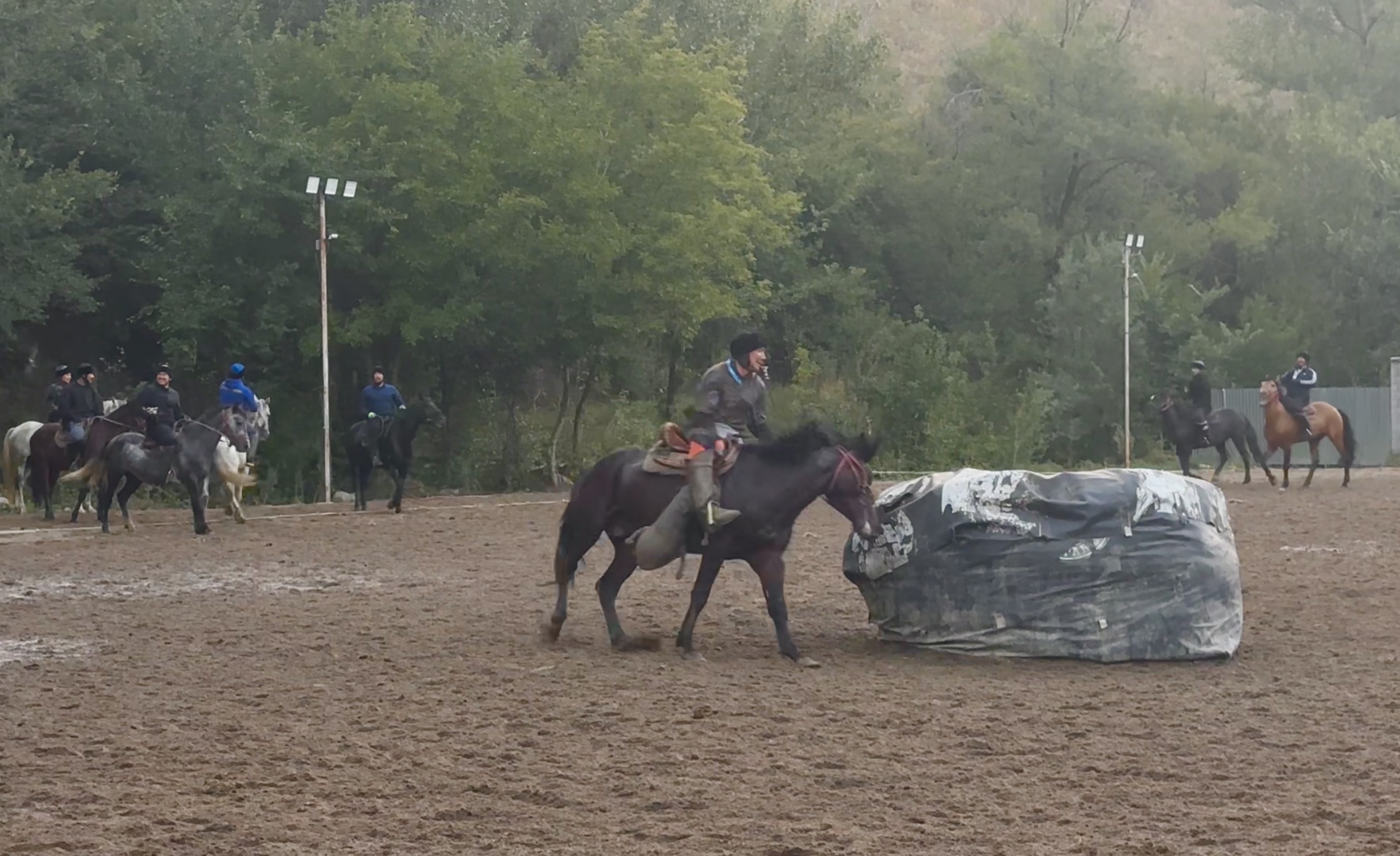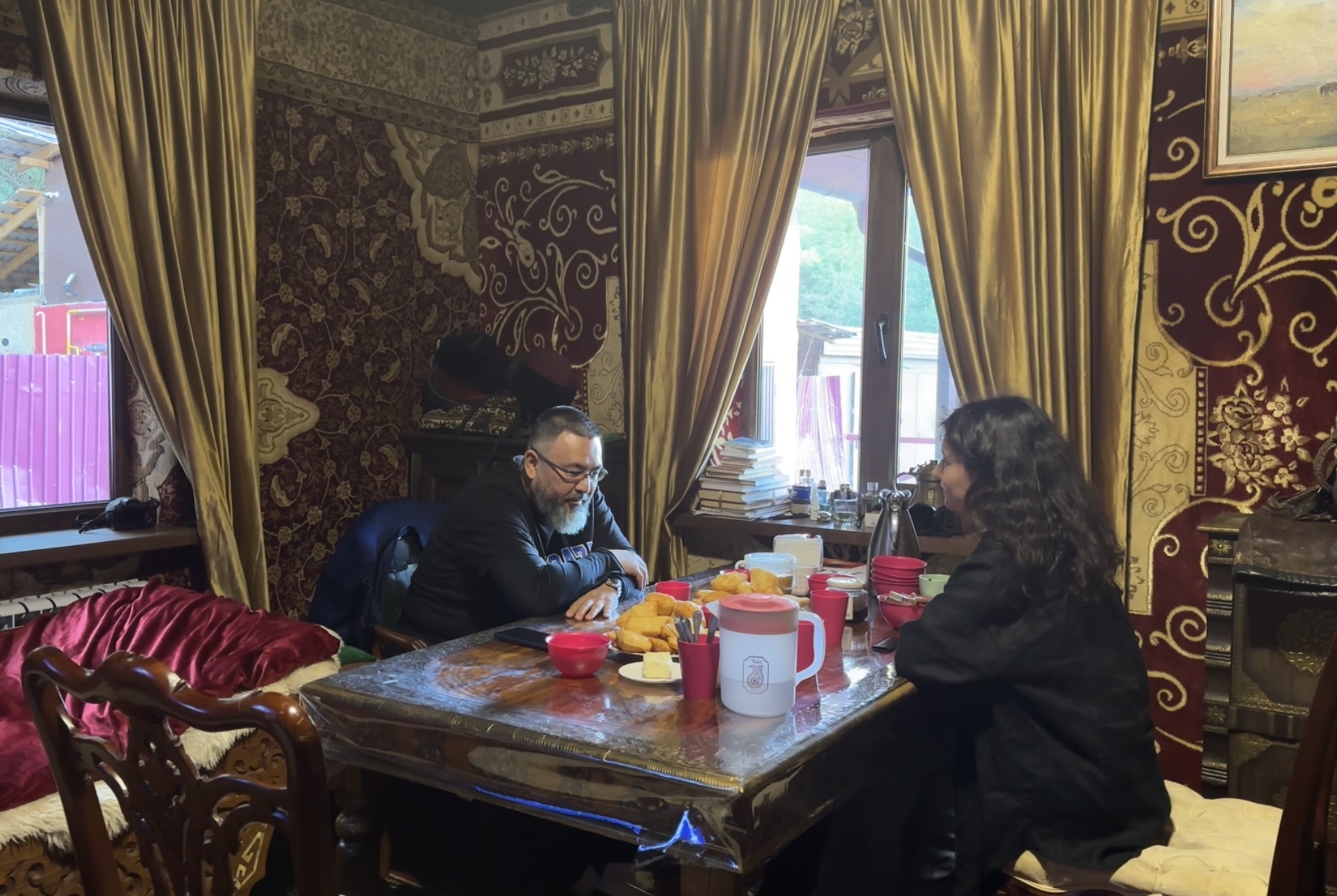ALMATY – Crowds are converging to witness kokpar, a traditional Central Asian game known as “goat pulling,” but it needs to be popularized at a smaller scale to truly celebrate the cultural heritage, said Daniyar Daukey, experienced kokpar player and owner of a kokpar club in Almaty, in an interview with The Astana Times.

A goat dummy is being picked up by kokpar players as training ahead of the game. Photo credit: The Astana Times
The ground trembles as a dozen horsemen charge their horses toward a goat carcass at the center of a 100-meter ring. A cloud of dust swirls around the horses when one rider reaches out and lifts the 25-kilogram carcass up and over his saddle. All he has to do now is to ride with the carcass and drop it into the opponent’s “boiler” to score. This is kokpar, one of the most masculine of traditional Kazakh games.
Originating from the Kazakh words for blue (kok) and wolf (bori), kokpar has been played in Central Asia for centuries, with variations existing in the Kyrgyz Republic, Tajikistan, Turkmenistan and Uzbekistan.
The sport is thought to be the inspiration for polo as it involves players on horseback who wrestle for control of a goat carcass to score a goal.
“In ancient times, our ancestors used to hunt for blue wolves with their bare hands. Sometimes, they would start a fight over who should carry the wolf back home,” said Daukey.

A player in action as he drops the goat dummy into the cauldron to score the goal. Photo credit: The Astana Times
With the advent of a more settled lifestyle in the southern regions of Kazakhstan, the hunting game evolved into a common tradition replacing the wolf with a goat or sheep carcass.
“When sultans longed for the steppes, they would gather strong men from nearby auyls (villages) for kokpar, but instead of a wolf, they would use a goat. The sultan would bet a prize. Kokpar mainly came from the south because the kents (cities) and villages were all in the south,” said Daukey.
Traditionally, hundreds of people participated in kokpar and games could last for hours. Later modifications turned the game into a structured sport with circled grounds and two teams, to ensure the safety of the players.
Kokpar club
Flanked by mountains, the training session takes place at Daukey Kokpar Club at the southeast edge of Almaty city near Koktobe hills. The riders are equipped with whips and armored in special shields over their clothes and high leather boots with knee protection.

Players prepare their horses ahead of a game by riding alongside each other. Photo credit: The Astana Times
Growing up in a city where the sport or even riding a horse was not popular, Daukey’s journey towards kokpar was rather unusual.
“I first mounted a horse at 25 when I acquired my initial chestnut horse, marking the inception of my equine love. My сhestnut horse was a real Kazakh horse on which I visited mountains and went hunting. It did not slip even once in the mountains,” said Daukey.
His fervor for horses grew into a passion for the kokpar game and establishing his own kokpar club. Daukey, now with over 30 years of experience, plays every day and trains amateur players along with 36 children for national and international tournaments.

Daniyar Daukey (L) during the interview with The Astana Times correspondent Aibarshyn Akhmetkali. Photo credit: The Astana Times
To promote kokpar extensively, Daukey inaugurated the Youth Kokpar League (YKL) in 2018, terming it “a more modern format suitable for the city.”
“The traditional game utilizes an area measuring 200 by 80 meters, whereas we employ a field of 100 by 50 meters, effectively half the size. We conduct our games in a cauldron as well, but ours is composed of grass. While conventional kokpar has teams of 12, our teams consist of only four members. Rather than using a slaughtered goat, we use a dummy,” explained Daukey, delineating the distinctions between his league and the traditional sport.
Synthetic goat carcasses are used to make the game more humane and are also more economical. “A slaughtered goat remains integral to traditional kokpar—it’s a component of the tradition. However, given the sportive evolution of the game, we opt to use a dummy,” said Daukey.
Resurgence of kokpar
Kazakhstan’s national game has enjoyed a resurgence in the last 10-15 years, according to Daukey.
“By the grace of God, we’re seeing a positive uptrend. Both mass kokpar and its traditional form are on the rise. This has increased the visibility of kokpar players, especially in the southern regions. Currently, mass kokpar is developing well in Astana as well,” said Daukey.
“In other regions, the YKL format might be more appropriate due to its economic advantages. It’s less financially intensive, requires fewer horses to be transported, and has already garnered significant popularity among spectators,” he added.
The tournaments are a rare chance to celebrate the heritage of Kazakhstan and popularize the traditional sport.
“We should raise [the status of] this sport among ourselves first. If a Kazakh holds our tradition in high esteem, it will pique global interest. We should not forget our roots, the traditions of our ancestors,” said Daukey.
Kokpar is included in the Fifth World Nomad Games scheduled for Sept. 8-15 next year in Astana.
Kokpar also requires a lot of physical endurance. An intense match that might last for hours exhausts both horses and riders. A man should be able to snag and lift the carcass. Although a dummy weighs around 25 kilograms, the real carcass could be as heavy as 40 kilograms. To lift the goat carcass from the ground, one has to lean down from the horse without falling.
“All visiting athletes acknowledge that kokpar is the ‘sultan’ of sports. It is very good for one’s health. A person sitting on a horse will have a strong spirit. It is good for the nerves. A person riding a horse forgets all his worries. In addition, it’s advantageous for alleviating spinal issues. Our ancestors did not suffer from diseases prevalent in modern times,” Daukey concluded.

